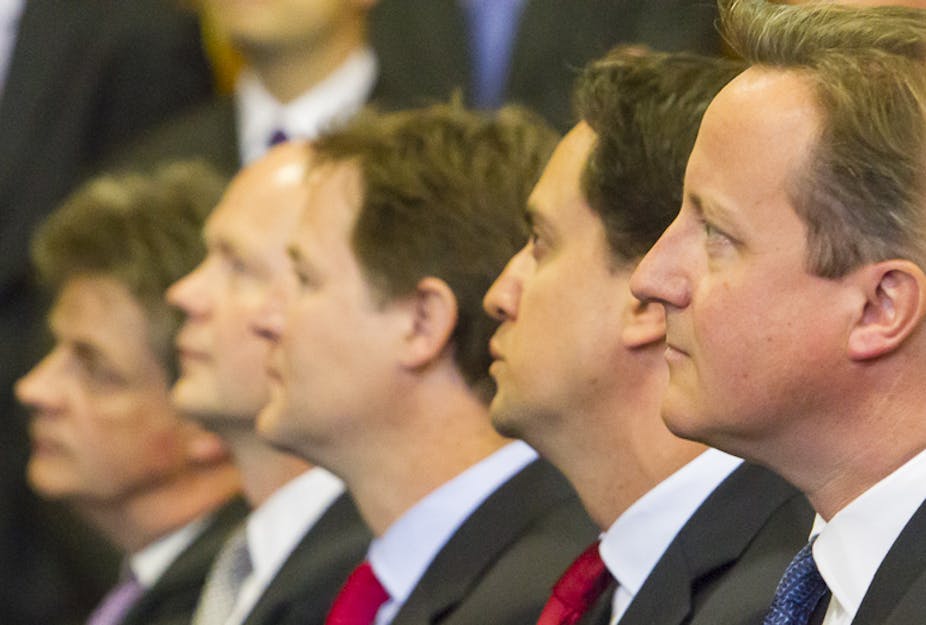However the next three months pan out, we may have already seen the most important moment of the 2015 election campaign. Environmental think tank the Green Alliance has managed to get the leaders of the UK’s three largest political parties to sign a cross-party agreement. David Cameron, Ed Miliband and Nick Clegg have stated for the record that climate change is real and have pledged to seek, among other things:
[A] fair strong and legally binding global climate deal which limits temperature rises to below two degrees.
It was a canny bit of politics by the Green Alliance and essentially means that climate change might just escape becoming an electoral campaign weapon in the hunt for votes and therefore escape the binary debate about the realities of the situation. It should also make us wonder if all the party leaders quite understand the dramatic extent of their apparent commitment.
There is, however, the argument that at least some of them might be thinking or hoping that this agreement will neutralise climate change from the election debate: “What’s the point in discussing it if we all have the same position?”
By degrees
If so, it will be up to us – commentators, media and the public – to make sure that they couldn’t be more wrong. This is the starting point for the real debate which we must ensure takes place. If the pledge is to limit temperature rises to below two degrees, what we need to probe hard between now and the election is exactly what they each think a binding deal needs to look like and what they are going to do to ensure that it is achieved.

Just to be clear, staying within two degrees is going to take very strong action. In effect it means that Cameron, Miliband and Clegg have pledged to strive for a trillion tonne cumulative carbon limit. My back-of-the-envelope modelling tells me that commitments currently on the table from the US, China and the EU would, if the rest of the world followed suit, be just enough to take us off the exponential emissions curve of 1.8% annual growth that we have been on for more than 160 years but would not be enough to stop us crashing through at least four degrees, and probably doing so this century.

What is required to stand a decent chance of staying within a two-degree change is for the EU and the US to more than double the rates of emissions cuts that they currently have on the table, and for China to bring forward its peak emissions date from 2030 to the early 2020s, with a rapid shrinking thereafter. We would then need the rest of the world to adopt similar ambitions. (These estimates are just made using my simplified climate models in Excel, but they generally produce results that are within a whisker of two of the results from the super computers so they will do for broad analysis).
This scenario would mean that we could see cumulative emissions plateauing at around 1.1 trillion tonnes
Realities
Do the party leaders understand what they have signed up to? I hope so. If not, what are they doing making the pledge? But let’s assume they understand the implications. That means we need to know what they are proposing to do to bring it about, or we should worry they are hoping to get away with telling us that they tried a bit but simply couldn’t deliver.

And now that these three have signed, the invitation is surely there for everyone else to sign up as well. Every constituency can ask all its candidates whether they too are prepared to sign. Every candidate from every party also now has a choice; do they sign and lay out for their electorate what their personal contribution will be? Or do they not sign, and ask the electorate to vote for them despite their deviation from both the party line and the scientific consensus?
So this is what I think needs to happen now:
The media should probe all party leaders on the details of how they are going fulfil to their pledge – what kind of deal they think would be good enough and how they are going to help bring it about.
In every constituency, all candidates should be invited to take the pledge and then asked to explain how they will fulfil it, or justify their position if not.
Congratulations should go out to the Green Alliance for providing this superb mechanism for dragging the three parties into a competition for the best green policies. And the Green party deserve praise for having had the most consistent, evidence-based and coherent policies on all this. We now have a mechanism for putting hard questions to those seeking our vote; it’s up to us to use it.

